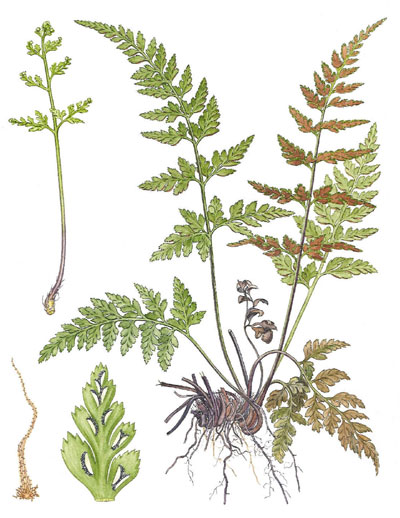| Asplenium adiantum-nigrum | ||
Black spleenwort | ||
|
Etymology
This confusing name indicates it is a spleenwort, alluding either to a certain likeness to
the Maidenhair Fern, or to its similarly water-repellent leaves, and black, nigrum, describing the scales.
Description
Rhizome: short-creeping, occasionally branching, scales clathrate, dark brown to blackish throughout, narrowly triangular, to 4 mm.
Frond: 20 cm high by 6 cm wide, evergreen, monomorphic, blade/stipe ratio: 1:2 to 3:2. Stipe: dark reddish brown at base, often fading to green above, more quickly on the upper side of the stipe/rachis, lustrous, somewhat swollen bases, black filiform scales and minute hairs, vascular bundles: 2 C-shaped, back to back, uniting to 1 upwards to an X-shape. Blade: 2-pinnate-pinnatifid, sometimes in the serpentine form more, at the base, always less upwards, oblong-triangular, widest at the base, firm, glossy, dark green, hairs/scales below, dark, scattered, minute, especially along the costae. Pinnae: 4 to 12 pair, opposite to alternate, anadromic, stemmed, variable in shape; pinnules ovate-lanceolate; margins coarsely incised; veins free, forking. Sori: linear, along a vein, on one or both sides, indusium: whitish, entire, opening toward the middle of the segment, sporangia: black, maturity: mid to late summer. Culture
Habitat: cliffs.
Distribution: relatively common in Europe, scattered distribution elsewhere, from the Himalayas to the Rockies to South Africa.
Hardy to -15�C, USDA Zone 7; however, the majority of horticultural selections are limited to Zone 8.
Distinctive Characteristics
The extended brown color of the stipe/rachis on the lower side only is unique. This is the most divided of all the Asplenium listed here.
Synonyms
Asplenium andrewsii A. Nelson Asplenium chihuahuense J. G. Baker Asplenium dubiosum Davenport |
|
|
|
Asplenium adiantum-nigrum. Sori in maturity are confluent, the indusia disappearing. Maui, Hawaii. �Photo by Forest & Kim Starr (USGS) |
